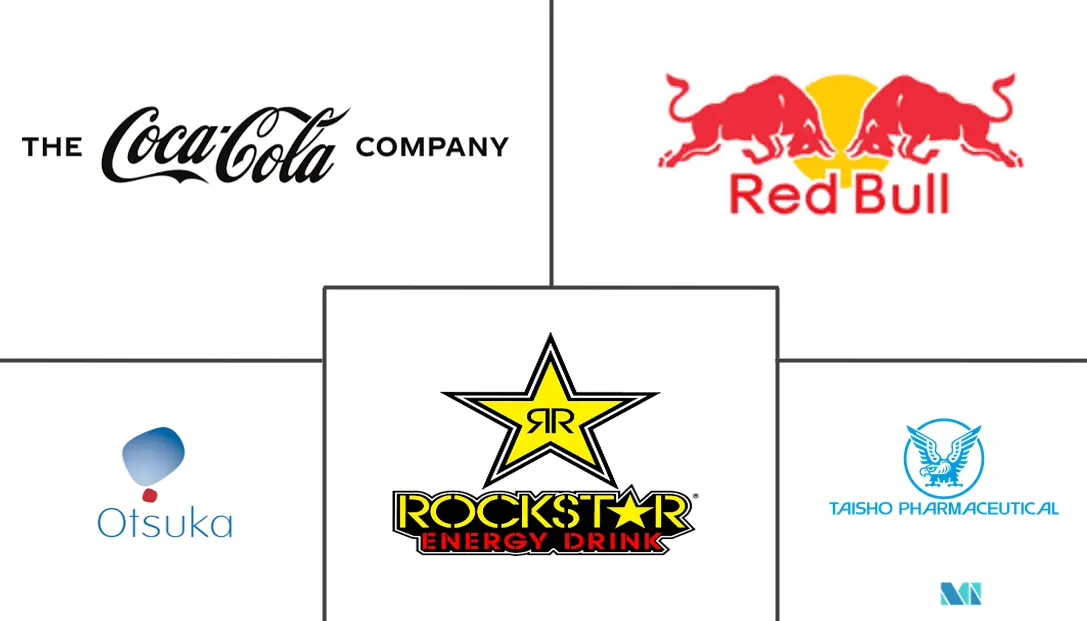Market Size of Japan Energy Drink Industry

| Study Period | 2019 - 2029 |
| Base Year For Estimation | 2023 |
| Forecast Data Period | 2024 - 2029 |
| Historical Data Period | 2019 - 2022 |
| CAGR | 14.50 % |
| Market Concentration | Low |
Major Players
*Disclaimer: Major Players sorted in no particular order |
Japanese Energy Drink Market Analysis
The Japanese energy drink market is estimated to register a CAGR of 14.5% over the next five years.
- By packaging, the canned energy drink segment is estimated to be the most preferred and highly consumed owing to its easy availability and convenience as long working schedules and hectic lifestyles become the norm. Hence, the working population, one of the major consumers of energy drinks, helped the demand for energy drinks stay afloat.
- In Japan, canned energy drinks are estimated to be the most preferred and highly consumed product owing to their easy availability and convenience. The energy drink market caters to the demand and changing consumer preferences of a large population of millennials in the country, owing to their perception that energy drinks are superior to other carbonated drinks in terms of health benefits. Therefore, factors such as these are driving the market studied.
- In addition, rising consumer lifestyle changes increased health consciousness, and awareness of health and wellness products are anticipated to drive market expansion over the coming years. Additionally, the popularity of products among teens is fueling the expansion of the industry.
- However, a caffeine overdose may result in hypertension, nausea, agitation, and other health problems that restrict the growth of the energy drink market. On the other hand, it is projected that a shift in consumer preference toward beverage consumption and a healthy lifestyle would open up the lucrative potential for market advancement throughout the projection period.
- Furthermore, increasing consumer awareness of maintaining good health reduces the frequency of gut-related disorders, like ulcers, Gastroesophageal Reflux Disease (GERD), gastroenteritis, etc., accelerating the consumption of energy drinks. Energy drink producers assert that their products increase energy.
- The popularity of energy drinks, which offer immediate energy along with mental and physical stimulation, is one of the main factors driving the market growth for energy drinks. Taurine is another important component necessary to grow skeletal muscle and the cardiovascular system. The growth of the Japanese energy drink market is primarily projected to be driven by these factors.
Japanese Energy Drink Industry Segmentation
Energy drinks contain stimulant compounds, usually caffeine, which provide physical and mental stimulation.
The Japanese energy drink market is segmented by type, packaging, and distribution channels. By type, the market is segmented into alcoholic and non-alcoholic. By packaging, the market is segmented into bottles and cans, and by distribution channel, the market is segmented into supermarkets/hypermarkets, specialty stores, convenience stores/grocery stores, online retail stores, and other distribution channels.
The report offers the size and forecast of the market in value (USD million) for all the above segments.
| Type | |
| Alcoholic | |
| Non-alcoholic |
| Packaging Type | |
| Bottles (Plastic and Glass) | |
| Cans |
| Distribution Channel | |
| Supermarkets/Hypermarkets | |
| Specialty Stores | |
| Convenience Stores/Grocery Stores | |
| Online Retail Stores | |
| Other Distribution Channels |
Japan Energy Drink Market Size Summary
The energy drink market in Japan is experiencing significant growth, driven by changing consumer preferences and lifestyle changes. The market is characterized by a strong demand for canned energy drinks, which are favored for their convenience and accessibility, particularly among the working population with demanding schedules. This trend is further supported by the increasing health consciousness among consumers, who are shifting from traditional soft drinks to functional beverages like energy drinks, perceived to offer better health benefits. The popularity of energy drinks is also bolstered by their appeal to millennials and teens, who view these beverages as a source of immediate energy and mental stimulation. Despite concerns over potential health risks associated with caffeine consumption, the market continues to expand, fueled by innovations in product offerings and packaging.
The competitive landscape of the Japanese energy drink market is dominated by major players such as The Coca-Cola Company, Red Bull GmbH, and Otsuka Pharmaceutical Co. Ltd, among others. These companies are investing in advanced distribution networks and innovative packaging solutions to meet the growing consumer demand. The market is also witnessing a rise in ready-to-drink beverages, which cater to the fast-paced lifestyles of consumers. Additionally, the introduction of new products, such as plant-based functional energy drinks, highlights the industry's focus on health and wellness. The market's growth is further supported by the availability of energy drinks in various retail formats, including kiosks, vending machines, and specialist stores, making them easily accessible to consumers across the country.
Japan Energy Drink Market Size - Table of Contents
-
1. MARKET DYNAMICS
-
1.1 Market Drivers
-
1.2 Market Restraints
-
1.3 Porter's Five Forces Analysis
-
1.3.1 Threat of New Entrants
-
1.3.2 Bargaining Power of Buyers/Consumers
-
1.3.3 Bargaining Power of Suppliers
-
1.3.4 Threat of Substitute Products
-
1.3.5 Intensity of Competitive Rivalry
-
-
-
2. MARKET SEGMENTATION
-
2.1 Type
-
2.1.1 Alcoholic
-
2.1.2 Non-alcoholic
-
-
2.2 Packaging Type
-
2.2.1 Bottles (Plastic and Glass)
-
2.2.2 Cans
-
-
2.3 Distribution Channel
-
2.3.1 Supermarkets/Hypermarkets
-
2.3.2 Specialty Stores
-
2.3.3 Convenience Stores/Grocery Stores
-
2.3.4 Online Retail Stores
-
2.3.5 Other Distribution Channels
-
-
Japan Energy Drink Market Size FAQs
What is the current Japan Energy Drink Market size?
The Japan Energy Drink Market is projected to register a CAGR of 14.5% during the forecast period (2024-2029)
Who are the key players in Japan Energy Drink Market?
The Coca-Cola Company, Red Bull GmbH, Otsuka Pharmaceutical Co. Ltd, Rockstar Inc. and Taisho Pharmaceutical Holdings are the major companies operating in the Japan Energy Drink Market.

